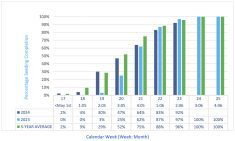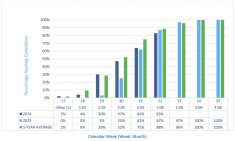Many areas of Manitoba received significant amounts of rainfall over the weekend, adding to the rainfall already received over the past few weeks.
The wet and cool weather conditions continue to impact crops as symptoms of excess moisture stress, including yellowing and slowed crop development are evident in many fields. Crop death has also been noted in the most severely impacted areas of the fields. It is anticipated that further crop damage will occur due to flooding and saturated soil conditions.
Wet conditions have also impacted herbicide and fungicide applications. Aerial application has increased as some fields are too wet for ground application.
Read Also

Sizing up Port of Churchill expansion challenges
The Port of Churchill has some hurdles to clear before it can become the sea trade powerhouse for Manitoba and Canada that governments and the agricultural industry hope it will.
Haying operations are also being hampered by wet weather and field conditions.
To download a pdf of the Manitoba Crop Report, click here.
Southwest Region
Excessive rain fell throughout the Southwest Region with accumulations ranging from 60 to 150 mm. The northern portions of the South Parkland including north and east of Minnedosa, Neepawa, north and east of Brandon and Rivers, along with areas south of Highway #1, saw significant precipitation. Crop damage and loss is expected due to flooding and saturated soil conditions.
Cereal crops seeded mid-May are at the penultimate leaf stage and will soon be in the boot and early flag leaf stage. Early seeded canola has started to bolt; however, high winds and heavy rainfall will impact growth and development. The winter wheat crop continues to improve but growth continues to be behind normal for this time of year. Most of the crop is in the boot to flag leaf stage of development. The fall rye crop continues to do well with many fields 75 to 100% headed. Soybean growth and development has slowed after its quick emergence. Some varieties are experiencing significant iron deficiency chlorosis symptoms due to the cool, wet growing conditions.
Prior to the rainfall, producers were busy with weed control as well as application of fungicides on winter wheat and early seeded spring wheat. Wet field conditions and flooding will impact further operations.
Flea beetle populations are on the decline, although they do continue to be an issue on some stressed canola fields. Cutworm feeding activity has also been noted, although feeding should subside shortly.
Due to the heavy rains, cattle are seeking high ground. Native hay ground is flooded. Alfalfa is in the bud to early bloom stage with the height of this year’s first cut at 75 to 80% of normal due to the cool, early season growing conditions. Wet conditions will further delay the start of harvest.
- More from the Manitoba Co-operator: Summer flood bulletin #4
Northwest Region
Rainfall amounts over the weekend in the Northwest Region ranged from 25 to over 125 mm. All areas in the Northwest Region, including areas around Ste. Rose, Roblin, Dauphin, Swan River and The Pas, are reporting saturated soils, ponding and flooding in many fields. Many rivers in the region are spilling over their banks.
Crops range in development. Most of the cereal crops in the region are at the seedling and tillering stage of growth. Approximately 50% of the canola crop is at the seedling stage and 50% is at or beyond the rosette stage. Soybeans are in the vegetative stage of growth, as are the majority of field peas. Approximately 75% of the grain corn crop is in the V1 to V5 stage of growth.
The earlier seeded, well-established crops on well-drained fields are continuing to grow. However, many crops are showing symptoms of moisture stress, including stunting and yellowing. Some crops require weed control measures and producers are unable to apply herbicides due to wet field conditions.
The significant rainfall last week resulted in pastures and forage fields flooded around Dauphin, as well as areas east of Dauphin. No haying progress was made, with the exception being a few fields harvested by dairy producers as silage. Alfalfa is in the early bloom stage. By the time fields dry up for harvest, alfalfa will be mature and therefore lowering feed quality.
Central Region
The Central Region saw normal to below normal temperatures for much of the week. Most of the region received 30 to 75 mm over the week, with the largest accumulations occurring Friday through Sunday. Higher precipitation amounts were seen north of Gladstone, areas along the Red River, and along the Canada/US border. Drains and creeks are running full. In the eastern areas of the region, some rivers are out of their banks, including the Red, Morris, and Plum. The Whitemud River and Big Grass Marsh are also full to overflowing. Standing water in fields is prevalent throughout the region as more fields are saturated with recent rains. High winds across the region also resulted in lodged cereal crops.
Advancement in crop growth continues to be slow, especially for the warm season crops such as grain corn and soybeans. Crop conditions vary as some areas have not received as much rainfall. Other crops are showing extreme excess moisture stress, particularly the broadleaf crops.
Late seeded cereals are tillering. The most advanced spring cereals are in early head emergence. Canola is in the two to four leaf stages to full flower. Most fields are in the rosette to bolting stage, with many starting to flower. Some fields are bolting and flowering due to excess moisture stress. Soybeans are in the unifoliate to third trifoliate stages, with the majority of fields in second to third trifoliate stages. Most fields are exhibiting some yellowing or iron chlorosis deficiency. Edible bean development ranges from emerging to sixth trifoliate stage, and are also showing iron chlorosis deficiency. Corn growth ranges from 4 to 10 leaf stage. Peas are up to ten nodes. Sunflowers are at the four to ten leaf stages. Most of the winter wheat has reached full head emergence, although many fields have variable plant staging.
Herbicide applications continue as field conditions allow. In the areas that are the wettest and with later seeded crops, producers are struggling to complete weed control applications. Weeds are growing rapidly, and field and weather conditions have made these operations a challenge. Rutting is evident in the wettest fields. Herbicide applications will continue in all crops as fields dry; however, it may take several days. Some applications are being made by air, and there are fields of all crop types that have not had a herbicide application.
In winter wheat, fungicide applications will target leaf diseases as timing for head blight will be difficult due to variable plant staging. Fungicide applications continue in spring cereals for leaf diseases, and some spring wheat acres will see an application for fusarium head blight suppression this week. Fungicide applications for sclerotinia continue, as the earliest seeded canola fields are in full flower. Many acres receiving fungicide treatments will be completed by aerial application due to saturated field conditions.
Flea beetle activity has declined. Diamondback moth monitoring is complete; overall numbers are low. Larval feeding activity was seen, but minimal. Monitoring began for bertha armyworm moths. Grasshoppers are emerging with high populations noted in some places. Headlands and roadsides were treated where numbers are the highest, as well as some fields.
Pasture conditions are generally rated as good across the region, although some pastures are rated as fair in the Pilot Mound area and north of Gladstone due to excess moisture. Hay crop is looking good; however, excess moisture is occurring in local areas. Alfalfa is in the early flower stage. The inclement weather is not allowing hay cutting to commence. Some hay was cut in the Pilot Mound area but will be slow drying with current weather and field conditions.
Eastern Region
Varying amounts of rainfall occurred throughout most of the Eastern Region. Cumulative rainfall varied from 15 to 75 mm. Standing water is very evident in fields. Stress symptoms in canola and spring cereals continue, including yellow and stunted growth. Plant death has been noted in some areas of fields. Below normal temperatures are slowing development of the warm season crops like soybeans and corn.
Cereal and canola crops continue to advance, although growth has been impacted by excess moisture. Soybeans have showing symptoms of iron chlorosis. Corn and sunflower crops are also yellowing due to the wet and cool weather. Winter wheat and established forage seed crops are rated as good. A return to warm sunny weather would be welcomed for all crop types.
Spraying progress is dependent upon field moisture. Some herbicide applications happened last week, as well as aerial applications of fungicides on winter wheat.
Haying in many parts of the region slowed considerably due to frequent showers and high moisture levels and humidity. Dairy farms have completed first cut of alfalfa with most of this feed being preserved as silage. First-cut alfalfa yields are reported as average to slightly above average. Beef producers would like take first cut soon, weather permitting. Pastures continue to be wet with standing water evident in some locations.
Interlake Region
Heavy rains fell throughout the Interlake Region last week, with the majority of rainfall occurring during the weekend. Amounts ranged from 50 to 102 mm, and in isolated areas anywhere from 100 to 152 mm. Strong south winds reaching up to 70 to 80 km/hr were experienced on Sunday.
Crops have started to show excess moisture stress as many crops are turning yellow. Many fields throughout the Interlake Region are flooding due to drainage ditches overflowing onto fields and roads. Crop damage will occur in low areas of fields, as well as places where flooding lasts for several days. Bee release for alfalfa seed production is halted as many producers cooled their bees to delay releasing. Winter wheat fields are in the heading stage throughout the region. The recent weather is making it difficult for producers to spray for fusarium head blight. Many canola fields have started to bolt in the south Interlake.
Little haying or ensiling has occurred to date. The excessive rainfall will delay haying and reduce yields. Yields are averaging 1.5 to 2 tons per acre for hay production. Pasture conditions are good, but in some areas pastures have begun to flood.














